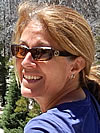
Isabel Montañez
University of California at Davis
2017 Laurence L. Sloss Award
Presented to Isabel Montañez
Citation by Michael C. Pope
Isabel P. Montañez, the 2017 Recipient of the Laurence L. Sloss Award, is highly deserving of this award, as her sedimentary and geochemical studies in paleoclimate and paleoceanography provide the quantitative framework for numerous other scientific studies, and she has an exemplary service record to the Geological Society of America (GSA). Dr. Montañez earned her B.A. in geology from Bryn Mawr College in 1981 and her Ph.D. in geology from Virginia Polytechnic Institute and State University in 1989. Isabel taught at the University of California at Riverside from 1990 to 1998 before moving to the University of California at Davis, where she has been a professor (and now distinguished professor) for 20 years.
Isabel is an extraordinary sedimentary geologist and geochemist whose approach to research is truly interdisciplinary working with paleontologists, biologists, modelers, soil scientists, geochronologists, and other geochemists to better understand Earth’s ocean, land, and atmospheric records of the last half billion years. Isabel’s research reconstructs sea level history and determines the composition of ancient seawater and the atmosphere, and unravels the complex interactions and feedbacks between life and climate during icehouse and greenhouse periods. Isabel’s research has developed and refined proxies of past atmospheric CO2 concentrations and paleoclimate conditions, providing “ground-truthing” and calibration of proxy approaches in marine and terrestrial studies. Her research provides environmental and chronologic frameworks for investigations of the changing redox state of the oceans, biodiversification events and extinctions, major climate transitions, and the linkage to continental-scale tectonics and weathering.
Isabel’s service includes editor of Sedimentology, Basin Research, Palaeogeography, Palaeoclimatology, Palaecology, and The Sedimentary Record. Isabel was a councilor for GSA and currently is serving as president of GSA. Isabel has worked tirelessly in shaping the NSF’s and the National Academy of Science’s appreciation of deep-time paleoclimate and paleoceanographic records and why what we (sedimentologists) do is important to our society and the world.
 2017 Laurence L. Sloss Award — Response by Isabel Montañez
2017 Laurence L. Sloss Award — Response by Isabel Montañez
I want to begin by thanking my nominator and citationist, Mike Pope, those who supported the award, and the Sedimentary Geology Division for honoring me with the Laurence L. Sloss award. It is a most wonderful experience when one receives such an accolade, but it is particularly special when it is completely unexpected. My career, like that of most academics, has not occurred in isolation. I’ve worked with a wonderful group of sedimentary geology students over the years. They have expanded my thinking through their keen curiosity and willingness to not blindly accept ideas but rather challenge them—including many offered by their advisor. Watching these students build thriving careers of their own has been tremendously rewarding. I’ve also been fortunate to work with many great colleagues over the years including in areas far afield from my own. From them I’ve learned how to read time in the rock record, the intricacies of the climate system, and to appreciate that the earth’s environment changes at the will of the life it supports, among many other things. And I would be remiss if I didn’t acknowledge the Carbonate Research Lab at Virginia Tech headed by J. Fred Read. When I joined the lab in 1983, I had no sense of how influential my geology formative years with fellow lab mates Steve Dorobek, John Grotzinger, Maya Elrick, Jim Niemann, and Dave Osleger would be. These cherished friends, including Fred and Krishna Sinha, a radiogenic isotope geochemist on the faculty at VA Tech, expanded my horizons daily, helped to build lots of great memories, and are part of the fabric of the geoscientist that I am today.
It is from all of these interactions that I have come to fully appreciate Earth as a dynamic system, one capable of change far greater than revealed by the past few 100s of thousands of years. The underpinning of my appreciation for the Earth system, however, is the sedimentary record—primarily the carbonate stratigraphic record. I was fortunate to learn to read this rich record from people such as Fred Read and James Wilson. I never had the opportunity to directly interact with Larry Sloss. But it is the work of the pioneers in stratigraphy, of which Larry was clearly one, who impressed upon me the value of the stratigraphic record. Geochemical data or modeling results out of context of this framework are nothing more than a lot of hard earned measurements or calculations. In these times when the importance of field and petrographic studies can be overshadowed by the emerging potential to measure the isotopes of most elements of the periodic table or to model nearly every process of the Earth system, it is that much more important to not lose sight of that lesson. I am privileged to continue to pass that on to budding geoscientists and in so doing to help carry on the legacy of Laurence L. Sloss.
